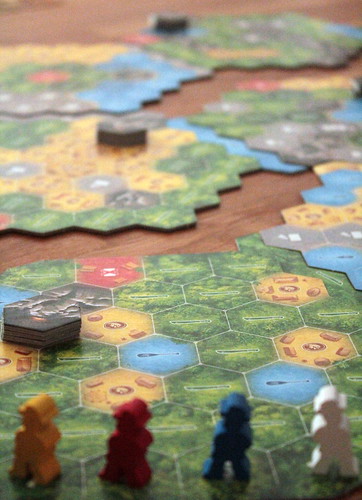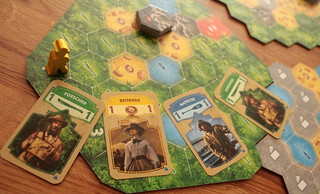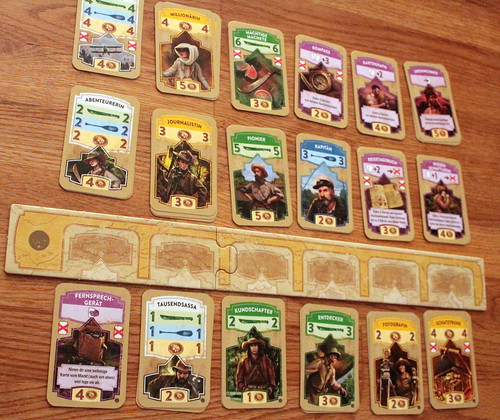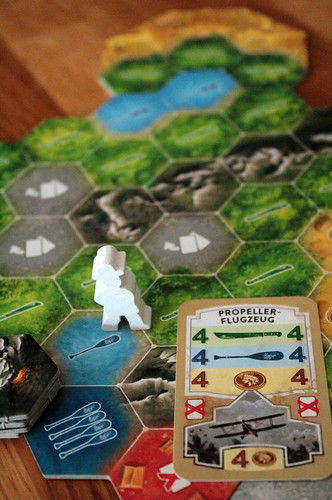| Strategy | Luck |
|---|---|
| Interaction | Components & Design |
| Complexity | Score |
The Quest for El Dorado packs everything the lyrics promise. There’s quite a lot of jungle, because that’s where the fabled city of El Dorado happens to be. And there’s a lot of fun and games for the whole family, because El Dorado is a family deck building game with enough fun in the box to earn a nomination for the 2017 Spiel des Jahres.
Please Enter Destination – The Rules
The first thing you’ll notice about The Quest for El Dorado is that it has a game board, still an unusual feature for deck-builders. The board is modular and shows a whole lot of jungle between your expedition and the golden city. How exactly that jungle looks depends on your setup. The game includes suggestions for games in different levels of difficulty, and if you get bored of those you can go wild inventing your own.

The jungle has different terrains, and your job is to steer your expedition through using your different cards. You start the game with eight cards in your deck and your turn with four cards in your hand. Many of those cards have no other purpose than to move you through the jungle.
The most numerous jungle spaces show forest and a number of machete symbols. To enter one of those spaces you play the right number of machetes from your hand. You can’t combine cards to get the required number of symbols, so at the start of the game you can only enter spaces with one machete using one of your Explorer card. Don’t worry, it’s a deck building game. You’ll get better cards.
The same applies for river spaces, the paddle symbol and the Sailor card and village spaces, the gold coin icon and the Traveler card. Two special types of spaces complete the excitement of your jungle expedition. On gray rubble spaces you must discard a number of cards, which is different from playing them because you don’t get their card effect, if they have one. At red base camps you “have to” destroy some cards from your hand. That means remove them from the game, not actually rip them. This isn’t a legacy game. I put “have to” in quotes because anyone with some experience playing deck-builders will tell you that removing cards from your deck is an awesome ability to keep your deck lean and quick.
Talking about deck-building, you obviously do that in The Quest for El Dorado. It’s not called a deck-building game for marketing reasons. If you had a starter deck in front of you you might wander why you have four travelers with gold coins although village spaces are relatively rare. That’s because those coins have a second purpose buying cards in the market. Cards with coins are worth the number of coins printed on them. Other cards can, in an emergency, be used as 0.5 coins.

There are six types of cards in the market, and only three copies of each card. Competition can get rather stiff at times. When the game starts your selection is pretty basic. Scouts and Trailblazers provide more machetes. Photographers provide more coins. So do Treasure Chests, but you destroy those after using them once. The Jack-of-all-Trades is a wildcard and provides you one icon of whichever kind you need. Finally, there’s the Transmitter, the one basic card with more interesting applications. It’s another card that you destroy after use, but that one time you use it you may take any card from the supply without paying, including cards not yet available in the market.
The difference between the supply and the market is an interesting idea in The Quest for El Dorado, and not one I’ve seen in other deck-builders. There are six spaces on the market tableau, six basic types of cards in the market, and twelve more types of cards in the supply. You can only get to those cards when the market tableau has an empty space. In that case you may buy a card from the supply. The remaining cards of that type fill the empty space in the market. Now there is no empty space in the market and the next player can’t choose to buy from the supply. This way players select which cards are available to other players. That opens some interesting options.

The cards starting in the supply are all useful, but not all are interesting. There are cards with more machetes, more coins, more paddles. Useful, but not interesting. There’s the Prop Plane, a wildcard with four symbols of any type that you destroy after use. Maybe you need a better pilot? Buying Pioneers with five machetes or Captains with three paddles is a no-brainer, you can always use those. Spend your money on a great card like the Prop Plane that you only use once is a more interesting decision.
For other cards you’re also not so sure if buying them is a good idea or not. Cartographer and Compass let you draw more cards. Great in general, but in some games they don’t get too much mileage. The Scientist is always a welcome addition to your expedition because she can destroy cards without the need for a base camp. The Native, with extensive knowledge of the terrain, can enter any space and ignore its requirements. That’s some awesome flexibility, but he’ll always guide you exactly one space. For the same price the Pioneer can move you up to five spaces, if they all show one machete.
If you picked your cards right, you’ll be the first to reach El Dorado and win the game.
You have reached your Destination – The Verdict
A family-friendly deck-building racing game is a big promise, and The Quest for El Dorado delivers. You’re racing through the jungle, you’re building a deck, and playing with your family is no problem at all. The rules are light enough and the game is quick enough that playing with kids works beautifully.
One thing that experienced gamers will find unexpected is how deck-building works. Many deck builders, like the genre grandfather Dominion, place a lot of emphasis on building card combos that produce awesome effects together. The Quest for El Dorado is different. Card combos aren’t a thing here. Every card has to pull its own weight to get you through the jungle. The most important bit here is keeping your deck lean. Only buy cards you know will help you, destroy all the cards you can do without. This fits well with the game’s theme. Only carry things you need into the jungle.

This deck efficiency thing is the one small obstacle to playing with kids. Even at the minimum age of ten, not all kids will immediately grasp the idea that destroying cards, even though they are technically useful, can make your whole deck better. But kids are quick learners. Expect them to kick your ass by the fourth game or so.
Another great thing about The Quest for El Dorado is how building your deck and planning your route interact. On the suggested setups, especially the more difficult ones, there are always different routes to El Dorado. Some will be much shorter in number of spaces, but you’ll need some cards with lots of symbols to make it through. Others take the long way, but a Pioneer can really eat up the distance on a stretch of one-machete forests. The decision which way to go only becomes more interesting when playing with the Cave rules. With that variant some spaces will reward you with useful bonus tiles for stopping next to them, but those spaces are not exactly next to the highway. Are they worth a detour? Who knows.
Not quite everything is gold in El Dorado, however. The one piece where I’m not happy is interaction. As long as players are close together in the jungle, there’s no problem. You can block opponents’ paths, move around them, pay attention how they build their deck and build yours so they won’t be able to block you. Cool. It stops being cool when one player pulls ahead. The only option to stop them now is to not let them get the cards they want from the market. That doesn’t work all that well, and it slows you down just as much as them. I understand non-confrontational design for family games, but The Quest for El Dorado really needed some cards to slow opponents down. Discard two random cards, maybe even lose a turn, destroy the card after use? Something to be able to catch up.
That complaint is not exactly a minor thing, but neither is it a dealbreaker. Some games you’ll get annoyed that you can’t catch up, but fortunately games are short. If you lost this one, play again and build a better deck next time. The Quest for El Dorado is probably a bit too light for your gamer friends, but an excellent choice for family game night. And with the coming Heroes & Hexes expansion it looks like my one complaint might get fixed as well. So… welcome to the jungle!















